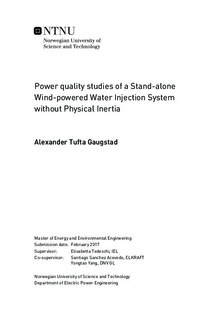Power quality studies of a Stand-alone Wind-powered Water Injection System without Physical Inertia
Master thesis
Permanent lenke
http://hdl.handle.net/11250/2440769Utgivelsesdato
2017Metadata
Vis full innførselSamlinger
- Institutt for elkraftteknikk [2465]
Sammendrag
The purpose of this thesis is to study the power quality in a stand-alone wind- powered water injection system for enhanced oil recovery. Water injection is crucial for boosting the recovery rate in mature oil reservoirs. The concept of a stand-alone wind-powered water injection system is to utilise a single wind turbine to solely power the water injection pump in an installation which is physically disconnected from the mother platform. The concept is possible due to recent technological developments within offshore floating wind power and advances within power electronic converters. The main objectives have been to develop a model in MATLAB/Simulink, implement coordinated control systems and study the power quality during common, and important scenarios.
The system is powered by a 6 MW permanent magnet synchronous generator which is directly driven by the wind turbine. The generator is interfaced with the microgrid main bus through a 2-level back-to-back voltage source converter, in order to obtain variable speed operation of the turbine. The main load is the water injection system which is driven by a 3 MW induction machine with pump loading. The induction machine is also interfaced with the microgrid through a 2-level back-to-back voltage source converter for speed control. The battery storage is responsible for supplying the fixed critical loads during low wind conditions, and to control the main bus voltage magnitude and frequency.
The wind turbine is tested through several common wind scenarios. The performance is shown to be a trade-off between the ability to follow the optimal speed and fluctuations in produced power. The turbine is further tested for fault ride-through capability and harmonic distortion.
Due to the slow pressurisation in hydrocarbon reservoirs, water is not required to be injected with a fixed rate. Thus, the water injection is performed only when there is wind power available. However, the wind is volatile, which makes it critical for the induction machine to be able to follow a rapidly fluctuating speed reference. This has been analysed in-depth. Another critical event of a microgrid is the capability of performing a black start. The battery has been tested and shown capable of establishing and maintaining the rated voltage and frequency of the microgrid.
The results obtained are thoroughly discussed throughout the thesis, simplifications and problems encountered have been highlighted.
